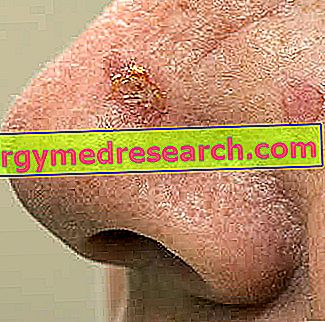Generality
Hyperacusis is a particular medical condition, characterized by extreme aversion and hypersensitivity to sounds that - for most people - are completely normal.

Doctors have long studied the possible causes of hyperacusis, but these are still a mystery at the moment.
Patients' reactions to annoying sounds are different: there are those who experience a growing sense of anxiety, those who need to cover their ears, those who enter a state of panic, etc.
For now, there is no specific treatment for hyperacusis. The therapies used by doctors are the so-called sound therapy, suitable for the treatment of tinnitus, and cognitive-behavioral therapy.
What is hyperacusis?
Hyperacusis is the medical term that indicates an extreme aversion and hypersensitivity to sounds that, as a rule, do not create any discomfort to people.
There are different degrees of hyperacusis. In fact, some patients are more sensitive than others and are annoyed by sounds that do not create any particular disturbance in the second.
Epidemiology
Hyperacusis can affect individuals of any age.
According to some recent statistical research, concerning the United Kingdom, it would concern between 7 and 23% of the adult population and between 12 and 27% of children.
Causes
The doctors have not yet established with certainty what the precise causes of hyperacusis are.
Until now, in fact, they have only formulated some theories, based on some experimental observations and nothing more.
HYPERACUSIA AND HEARING LOSS
A first theory associates hyperacusis with hearing loss .
According to supporters of this hypothesis, the brains of people with poor hearing would amplify the sound signals entering the ear, compensating for the reduction in hearing ability on the one hand, and causing discomfort to the subject concerned on the other.
The criticisms of this theory concern mainly the fact that not all individuals with sub-optimal hearing develop hyperacusis.
HYPERACUSIA AND SPECIAL SOFT CONDITIONS
According to a second important theory, hyperacusis would be a sort of symptom resulting from some medical conditions, including:
- Migraine . It is one of the most common primitive forms of headache. The primitive term referring to a medical condition means that this disorder does not depend on other diseases, but represents a problem in itself.

- Lyme disease . Caused by the bacterium Borrelia Burgdorferi, it is an infectious disease whose transmission agent is the tick. From a symptomatological point of view, it usually affects the skin and quite frequently also internal organs, joints and the nervous system.
- Bell's palsy . It is a facial paralysis, which occurs as a result of dysfunction of the VII facial nerve. Its appearance involves muscle weakness or paralysis in one side of the face.
- Addison's disease . It is a rare condition that originates due to a dysfunction of the adrenal glands (or adrenal glands). Located just above the kidneys, healthy adrenals produce, in their cortical portion, three types of hormones: androgens, glucocorticoids and mineralocorticoids.
- Autoimmune diseases . Autoimmune diseases are characterized by an exaggerated and improper response of the immune system (the natural barrier that protects the body from threats from the outside world, such as bacteria, viruses, fungi, etc.).
For unclear reasons, in individuals with an autoimmune disease, the elements that make up the immune system (mostly cells and glycoproteins) attack perfectly healthy tissues and organs, causing even very serious damage.
- The presence of tinnitus . Tinnitus is very annoying to the ears, perceived in the absence of external sound sources. They may be continuous or intermittent and may arise as a result of certain events or circumstances (exposure to loud noises, hypertension, atherosclerosis, etc.).
- Ménière's disease . It is a disease of the inner ear, which, due to an alteration of the nerve signal between the ear and the brain, causes vertigo, nausea and hearing loss. Unfortunately, the symptoms tend to worsen over time and, at the present time, there is still no specific cure.
HYPERACUSIA AND STRONG EMOTIONS
According to a third theory, people could develop an aversion to certain sounds, when they have characterized a past life experience in the negative.
In other words, in these situations, the hyperacusis would derive from associating a previous event with unpleasant contours to the sounds that have distinguished it.
According to the proponents of this theory, this would explain those cases of hyperacusis associated with the so - called post-traumatic stress disorder .
HYPERACUSIA AND DAMAGE TO EAR STRUCTURES
According to a fourth theory, a form of hyperacusis could arise later:
- A blow to the head or the so-called whiplash
- An ear surgery
- Persistent ear infections
- Prolonged exposure to loud noises
Symptoms
For symptoms and signs of hyperacusis, doctors understand the patient's reactions to sounds that are perceived as annoying .
Among these reactions, the most common are:
- Sense of growing anxiety
- Cry
- Panic
- Sulking
- Need to cover your ears
- Need to leave the room
For the most severe cases of hyperacusis, the sounds towards which there is aversion and hypersensitivity are as painful. In these situations, patients describe the sensation experienced as "a nail sticking in the head" or as "sandpaper passed over the brain".
THE MOST BEAUTIFUL NOISE FOR CHILDREN
According to the observations of the doctors, in children with hyperacusis the sounds that can cause discomfort are:
- The barking of dogs
- Loud, loud laughter
- The screams
- The sharp whistles
- The sound of thunder
- The sound of fireworks and firecrackers bursting
- The noise of high-capacity trucks, cars and motorcycles
- The ringing of the school bell or the loud buzz of voices that can be found in the classrooms
- The sound of bursting balloons
- The ambulance sirens
- Distorted sound tones of some musical instruments (for example, electric guitars)
- The ringing of the phones
- The noise of lawn-mowers, drills and floor cleaners
COMPLICATIONS

Furthermore, people with hyperacusis towards sounds they usually hear in the workplace may not be able to sustain this situation for long and abandon their working activity. This can have repercussions, sometimes very serious, on their finances.
Complications in children
Children with an aversion to sounds they usually hear at school may lack the necessary concentration in the classroom, jeopardizing their educational background and performance.
Diagnosis
Doctors find it difficult to distinguish a slight acoustic intolerance from an aversion with hypersensitivity to certain sounds. The reason is very simple: they must rely exclusively on what the patient reports and the degree of objectivity of the latter.
To achieve an accurate and correct diagnosis, some audiometric tests are essential, which are used to assess the degree of acoustic hypersensitivity.
WHAT DO THE AUDIOMETRIC TESTS CONSIST OF?
During the audiometric tests, the doctor makes the patient listen to sounds of increasing intensity, asking the patient to signal when the perceived noise becomes unbearable.
Among the audiometric evaluations usually practiced, there are: tonal audiometry, the strapedial reflex test and the LDL test (where LDL stands for "Loudness Discomfort Level", ie "sound intensity of the level of discomfort").
WHO IS THE DIAGNOSIS FOR?
In general, for a correct diagnosis of hyperacusis, it is good to rely on an otolaryngologist or a specialist in audiometry .
Treatment
Doctors have not yet succeeded in developing a specific therapy against hyperacusis; however, in the course of their experimental tests, they realized that the so-called sound therapy, adopted for the treatment of tinnitus, is able to satisfactorily reduce also a certain degree of acoustic aversion and hypersensitivity.
Moreover, it is recent discovery that some particular cases of hyperacusis benefit from the so - called cognitive-behavioral therapy .
SOUND THERAPY: THE BASIC CONCEPTS
In the presence of hyperacusis, the purpose of sound therapy is the patient's acoustic desensitization . In medicine, the term desensitization refers to that set of processes aimed at reducing (or, at best, resolving) a state of abnormal sensitivity to certain substances. In practical terms, these processes consist in administering progressively increasing doses of the offending substance to the patient (ie the one to which the patient is highly sensitive).
Clearly, in the case of an acoustic desensitization, the "substances" to be "administered in increasing doses" are annoying noises.
Note: the desensitization technique is particularly suitable in case of allergies. In these situations, the term substance is appropriate, because it refers to the allergen to which the patient is hypersensitive.
MODE? AND TIMES OF SOUND THERAPY
Sound therapy involves applying a sound dispenser to the patient's ear.
This particular instrument can emit noises of adjustable intensity, which allows the desensitization treatment to be carried out precisely.
Exposure to annoying noises must occur daily: in the initial phase, the daily treatment hours range from 6 to 8; at a later stage they may even become less than 6, provided however that the therapy is effective.
Initially, the intensity of the sounds delivered by the instrument is at levels that do not cause the patient any discomfort. Moreover, if I were not like this, the treatment would be completely useless.
An acoustic desensitization for the treatment of hyperacusis lasts for several months: in general, most patients must use the sound dispenser for a good 12-18 months.
SOME ADVICES
According to some research, they seem to bring benefits:
- Relaxation and stress control techniques. According to many doctors, stress worsens hyperacusis.
- Listen to relaxing music. Helps reduce the stress of everyday life.
- Avoid using ear plugs. Ear plugs alter the perception of sounds and this could adversely affect sound therapy.
BEHAVIORAL COGNITIVE THERAPY
The purpose of cognitive-behavioral therapy is to let the patient know about the disease from which he suffers in every respect (symptoms, complications, etc.), so that he can somehow dominate it. Generally, this particular treatment is reserved for mental illnesses; however, doctors have noted that it is also effective against hyperacusis characterized by severe growing anxiety crises.




